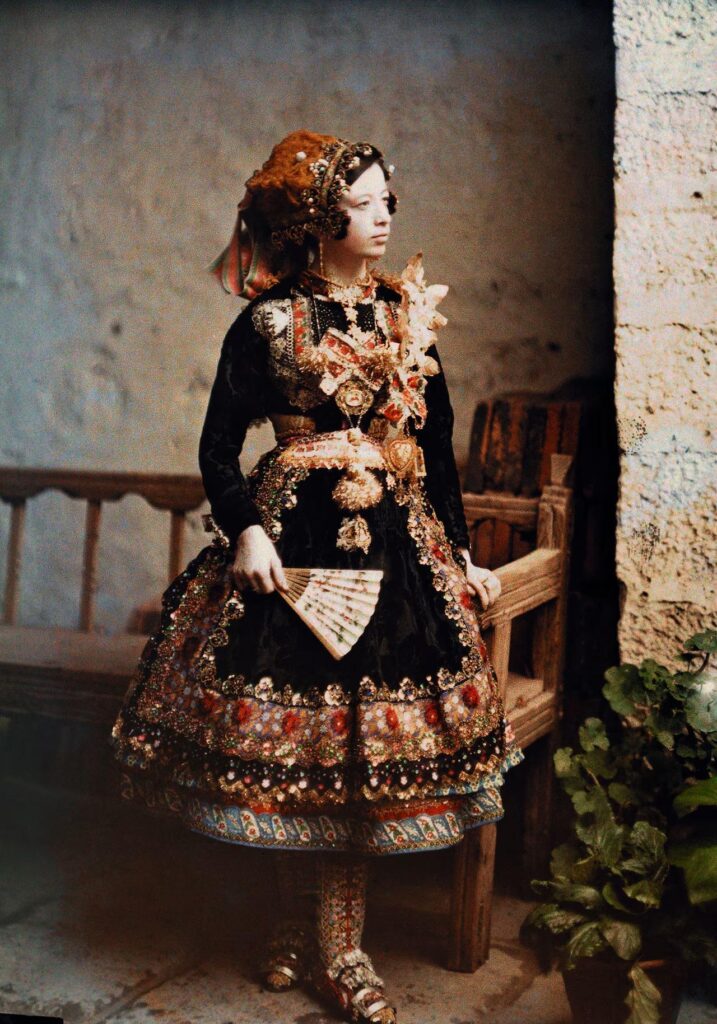Capturing Tradition in Color
In 1914, French photographer Jules Gervais-Courtellemont created a timeless portrait of a young woman in Lagartera, Spain, using the groundbreaking autochrome process. This early form of color photography, patented by the Lumière brothers in 1907, allowed for vivid, true-to-life depictions that had never been possible before. The resulting image not only showcases the woman but also provides a window into the rich cultural traditions of her homeland.
The Autochrome Process: Revolutionizing Photography
The autochrome process used by Courtellemont was revolutionary for its time. By utilizing a mosaic of dyed potato starch grains, the technique created a vibrant color palette that brought photographs to life. This method was particularly suited for capturing textures and details, making it ideal for documenting traditional clothing and intricate patterns. Courtellemont’s use of this medium enhanced the vibrancy of the embroidered textiles, emphasizing the artistry of Lagartera’s craftsmanship.
Traditional Clothing of Lagartera
The woman in Courtellemont’s portrait wears a traditional Lagartera ensemble, a stunning example of the region’s centuries-old embroidery tradition.
- H3: Intricate Embroidery
Lagartera embroidery is characterized by its vivid colors, geometric patterns, and meticulous craftsmanship. Often created for special occasions, these garments reflected both cultural pride and the wearer’s social status. The embroidery techniques of Lagartera have been passed down through generations, ensuring that the tradition remains alive. - H3: Symbolism in Textiles
Traditional clothing in regions like Lagartera often carried deeper meanings. The motifs and designs embroidered on garments were not merely decorative but could symbolize fertility, protection, or religious devotion. These garments often blended practicality with beauty, showcasing the harmony of utility and artistry.

The Role of Women in Preserving Tradition
Women were central to the preservation of textile traditions in Spain. From a young age, girls learned embroidery skills as part of their domestic education, ensuring that these cultural practices endured. The act of creating and wearing these garments was not only a reflection of personal skill but also a way of contributing to the cultural and social identity of their community.
Informal Portraiture and Authenticity
Courtellemont’s portrait stands out for its informal composition. Unlike staged studio photographs common in the early 20th century, this image feels candid, offering a sense of immediacy and intimacy. The young woman’s relaxed pose and direct gaze connect the viewer to her world, bridging the gap between past and present.
Preserving Heritage Through Photography
Courtellemont’s work goes beyond documentation; it serves as a historical record of a vibrant cultural moment. By capturing this woman and her traditional attire, the photograph immortalizes the artistic and social heritage of Lagartera. At a time when industrialization threatened many traditional crafts, such images became essential in preserving the memory of these practices for future generations.
The Legacy of Lagartera’s Embroidery Today
Though modernization has changed the way of life in many rural Spanish communities, Lagartera’s embroidery remains a celebrated craft. Efforts by artisans and cultural organizations continue to preserve these techniques, ensuring that the intricate beauty of Lagartera embroidery lives on.
Conclusion: A Glimpse into the Past
Jules Gervais-Courtellemont’s 1914 photograph is more than a portrait; it is a celebration of tradition, artistry, and heritage. By capturing the vibrant details of Lagartera’s traditional clothing, he preserved a moment in time that continues to inspire admiration and curiosity. This photograph reminds us of the enduring importance of cultural preservation and the beauty of human craftsmanship.
